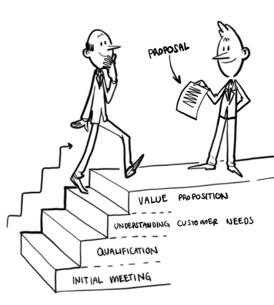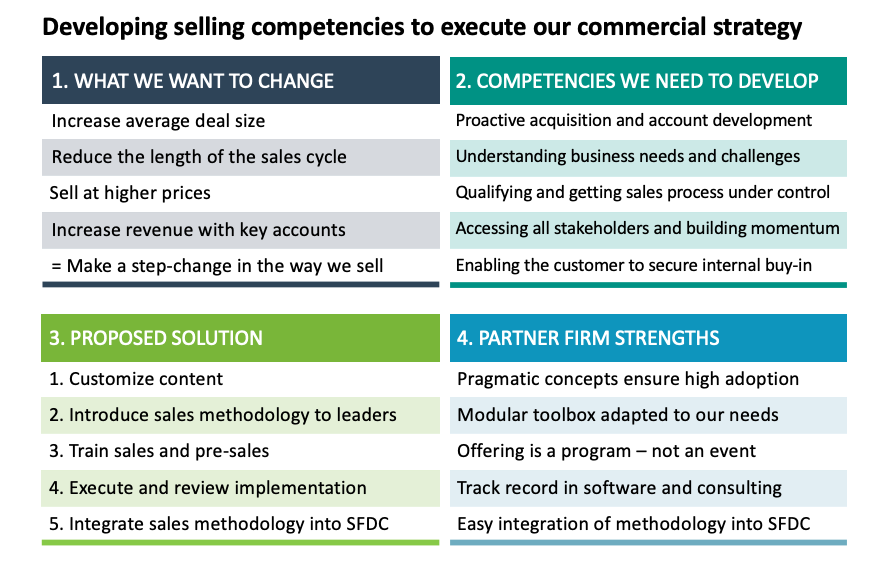 Sales people who fail, often blame price. Good sales people not only make the sale but they avoid or minimise price concessions and their customers believe they’ve received great value. We see the same mistakes repeated regularly in today’s tough B2B environment, so here are the 5 most common errors and how you can avoid them.
Sales people who fail, often blame price. Good sales people not only make the sale but they avoid or minimise price concessions and their customers believe they’ve received great value. We see the same mistakes repeated regularly in today’s tough B2B environment, so here are the 5 most common errors and how you can avoid them.
1. Submitting your price before establishing the value
How often do you get driven by the customer to give a price early in the sales cycle? Developing and quantifying your value proposition is the golden rule of a good sales process.
Recommendation: Acknowledge that price is important and say that you will give them a price but first you need to ask a few questions. Try ‘I know price is a very important part of your decision and I promise that I’ll provide you with a detailed price quote. Now can I ask you a few more questions to ensure I only price what you need?’.
Recommendation: Build test-drives into your sales process to ensure that the customer experiences your value proposition before talking about price.
2. Selling to the wrong people
Procurement is an easy place to start because they are interested in having a portfolio of alternative suppliers. But they are well-trained in blocking access to the business and focusing the discussion solely on price, not value.
Recommendation: Be sure to identify all roles in the Buying Center for your opportunity. Your action plan needs to take you to the business decision makers as quickly as possible. It might be more challenging to obtain an initial meeting but, once you do, it is easier to navigate through the Buying Center and to focus the conversation on value.
3. Not developing a business case
Decision-makers do not have much trust in vendor-supplied metrics. They need to see customized and detailed metrics for the specific solution offered.
Recommendation: Use business cases early on to demonstrate the ROI you can deliver. Then offer to develop a business case for your customer. A business case immediately lifts the quality of your discussions with your customers, as it quantifies how your solution will impact the customer’s business. Better yet, it connects your solution to the finance and senior business executives whose KPIs your solution will impact, broadening your engagement beyond the evaluation team. It’s the quantified justification for the decision to buy and must include a quantification of your competitive differentiators.
4. Not equipping your sponsors to sell internally
If the Buying Center is large, there are often people involved in the buying decision you will never meet. The risk is that they only see your price but not your value.
Recommendation: Equip your contacts with the information they need to secure internal buy-in. The Deal One-Pager is the key tool here. It’s important to use the language of your customer. We used a Deal One-Pager in a recent pitch we won at a Dutch tech company. We lacked contact to the CEO but our highest contact used our Deal One-Pager in the meeting he had with him. The headings were What We Want to Change, Competencies We Need to Develop, Proposed Solution and Partner Firm Strengths.

5. Failing to prepare for negotiation
Recommendation: When preparing for a negotiation, it’s important to be clear about your opening, walk away and target position. But it is equally important to brainstorm your trading variables. Concessions must always be conditional.
For instance, I am currently negotiating with a large corporation and they say they have a specific budget and it’s less than I want. I have negotiated them up a bit by showing value but there is still a gap. So, I have offered a discount if they pay up front – cash flow has a value to my business but makes little difference to the people I am dealing with. We call this trading variables of unequal value.
Basically, it’s quite simple – people will pay more for something they value highly. Concentrate on showing and quantifying the value of your solution to the right people and customers will pay for it. It’s a question of leading the customer rather than following the customer!
Questions to ask yourself
- Are your sales conversations about value or price?
- Do you engage with the right people?
- How do you equip the customer to sell internally?
- How much higher could your revenue be if you were better at selling value?
